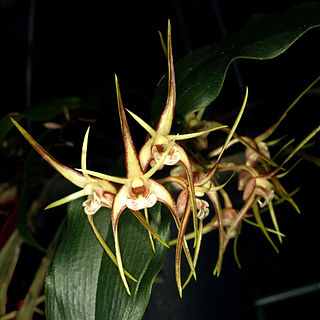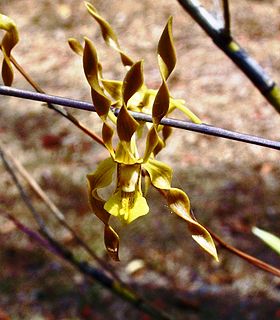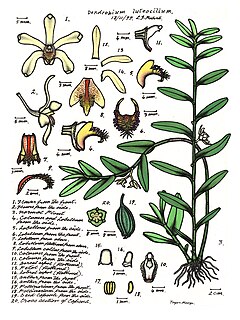
Dendrobium antennatum, commonly known as the green antelope orchid, is an epiphytic orchid in the family Orchidaceae. It has cylindrical pseudobulbs with up to twelve leaves near their tips and up to fifteen white flowers with green petals and a white labellum with purple stripes. It grows in New Guinea and in tropical North Queensland where it is rare.

Dendrobium bigibbum, commonly known as the Cooktown orchid or mauve butterfly orchid, is an epiphytic or lithophytic orchid in the family Orchidaceae. It has cylindrical pseudobulbs, each with between three and five green or purplish leaves and arching flowering stems with up to twenty, usually lilac-purple flowers. It occurs in tropical North Queensland, Australia and New Guinea.

Dendrobium discolor, commonly known as antler orchids, are epiphytic or lithophytic orchids in the family Orchidaceae. They have cylindrical pseudobulbs, each with between ten and thirty five leathery leaves, and flowering stems with up to forty mostly brownish or greenish flowers with wavy and twisted sepals and petals. Antler orchids occur in northern Australia, New Guinea and Indonesia and there are several subspecies and varieties.

Dendrobium jonesii, commonly known as the oak orchid is a species of epiphytic or lithophytic orchid endemic to far north Queensland. It has spindle-shaped pseudobulbs, up to seven thin, dark green leaves and up to thirty five crowded, star-like, fragrant cream-coloured or white flowers with purple markings on the labellum.

Dendrobium tetragonum, commonly known as the tree spider orchid, is a variable species of epiphytic or lithophytic orchid endemic to eastern Australia. Tree spider orchids are unusual in having pendulous pseudobulbs that are thin and wiry near the base then expand into a fleshy, four-sided upper section before tapering at the tip. There are only a few thin but leathery leaves at the end of the pseudobulbs and up to five flowers on relatively short flowering stems. To allow for the variations in the species there are five subspecies and a variety, some with a unique common name.

Dendrobium smillieae, commonly known as the bottlebrush orchid, is an epiphytic or lithophytic orchid with large, spongy pseudobulbs, thin, bright green leaves which are shed after their first year and crowded flowers in a bottlebrush-like arrangement. The flowers are white, to cream-coloured or pink and the labellum has a shiny, dark green tip. This orchid species is found in some of the Torres Strait Islands, and through Cape York Peninsula to Townsville, Queensland. It is also found in New Guinea and eastern Indonesia.

Dendrobium johannis, commonly known as the chocolate tea tree orchid, is a species of epiphytic or lithophytic orchid native to Australia and New Guinea. It has spindle-shaped pseudobulbs, between five and ten dark green leaves with purplish markings and flowering stems with up to fifteen chocolate brown flowers with a yellow labellum.

Dendrobium trilamellatum, commonly known as the fragrant tea tree orchid or large tea tree orchid, is a species of epiphytic orchid found in northern Australia and New Guinea. It has spindle-shaped pseudobulbs, between three and seven leathery, dark green leaves and between three and fifteen yellow, yellowish brown or brown flowers with a mauve to purple labellum.

Dendrobium callitrophilum, commonly known as the thin feather orchid, is an epiphytic orchid in the family Orchidaceae with narrow pseudobulbs, one or two thin, leathery leaves and up to six greenish yellow flowers with a cream-coloured or apricot-coloured labellum. It grows in or near rainforest in isolated parts of tropical North Queensland.

Dendrobium falcorostrum, commonly known as the beech orchid, is a species of epiphytic orchid endemic to eastern Australia. It has spindle-shaped pseudobulbs, each with between two and five leathery leaves and up to twenty crowded white flowers with purple markings on the labellum.

Dendrobium adae, commonly known as the slender cane orchid, is an epiphytic, sometimes lithophytic orchid in the family Orchidaceae. It has cylindrical pseudobulbs, up to four dark green leaves and up to six white or greenish to apricot-coloured flowers. It grows in tropical North Queensland, Australia.
Dendrobium fellowsii, commonly known as the native damsel orchid, is an epiphytic or lithophytic orchid in the family Orchidaceae and has upright pseudobulbs, up to five leaves and groups of up to five pale green or yellowish flowers with a deep purple labellum. It grows in tropical North Queensland.

Dendrobium canaliculatum, commonly known as the brown tea tree orchid or thin tea tree orchid, is an epiphytic or lithophytic orchid in the family Orchidaceae. It has cone-shaped or onion-shaped pseudobulbs, up to six deeply channelled, dark green leaves and up to thirty star-shaped, light brown to caramel-coloured white or greenish to apricot-coloured flowers with darker tips. It grows in tropical North Queensland and New Guinea.

Dendrobium fleckeri, commonly known as the apricot cane orchid, is a species of epiphytic or lithophytic orchid endemic to far north Queensland, Australia. It has cylindrical pseudobulbs with two or three dark green leaves and up to four apricot-coloured or yellowish green flowers with tangled white hairs on the edge of the labellum.

Dendrobium pruinosum, commonly known as the honey orchid, is an epiphytic or lithophytic orchid in the family Orchidaceae and has flattened, yellowish stems and pairs of cream coloured, dull yellow or greenish flowers. It grows in tropical North Queensland and New Guinea.

Dendrobium nindii, commonly known as the blue antler orchid, is an epiphytic or lithophytic orchid in the family Orchidaceae. It has erect, cylindrical, leafy pseudobulbs with leathery, dark green leaves and up to twenty mauve or violet flowers with darker veins on the labellum. This antler orchid occurs in tropical North Queensland and New Guinea.
Dendrobium eungellensis, is an epiphytic orchid in the family Orchidaceae and is endemic to northern Queensland. It has dark greenish brown pseudobulbs with up to three leaves on the end and up to eight fragrant white flowers with thin, spreading sepals and petals. It grows in open forest in the Eungella National Park.
Dendrobium clementsii, commonly known as the Cape York crimp orchid, is a species of epiphytic or lithophytic orchid that is endemic to tropical North Queensland, Australia. It has long stems, tapering pseudobulbs each with a thin, leathery dark green leaf and clusters of short-lived, cream-coloured flowers with a purple labellum.
Dendrobium neospectabile, commonly known as the Eungella king orchid, is a species of epiphytic or lithophytic orchid that is endemic to tropical North Queensland. It has cylindrical, yellowish green pseudobulbs, up to three thick, leathery leaves and up to two hundred and fifty crowded cream-coloured to pale yellow flowers with reddish purple streaks on the labellum.
Dendrobium deuteroeburneum, commonly known as the rainforest feather orchid, is a species of epiphytic or lithophytic orchid that is endemic to eastern Australia. Its pseudobulbs are cylindrical, pressed against the host tree or rock and have one or two leathery, dark green leaves and up to seven pale greenish cream-coloured flowers with purple markings on the labellum.
















